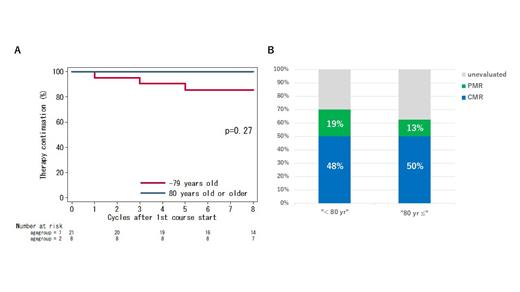Background: The standard treatment for newly diagnosed DLBCL has been R-CHOP for many years. Recently, Pola-R-CHP using polatuzumab vedotin has been reported to have superior efficacy to R-CHOP and is available as first-line treatment for DLBCL. However, the patients in the phase 3 POLARIX trial were under 80, and the efficacy and safety for patients over 80 are not established. To investigate the efficacy and safety of Pola-R-CHP in the elderly, we conducted this study.
Patients and Methods: From September 2022 to March 2023, we retrospectively analyzed patients with newly diagnosed DLBCL treated with Pola-R-CHP at Anjo Kosei Hospital. Patients previously treated for hematologic malignancies were excluded. The dosages of polatuzumab vedotin and rituximab were not reduced, and the dosages of cyclophosphamide, doxorubicin, and prednisone or treatment schedules were determined by the treating physician. The primary endpoint was the rate of treatment continuation without early termination, and secondary endpoints were efficacy, progression free survival (PFS), and safety.
Results: A total of 29 patients (younger group: under 80, n = 21; elderly group: over 80, n = 8) were consecutively enrolled. The median age in the younger group was 64 (range 42-78) and in the elderly group was 82.5 (range 80-94). Patient characteristics, including history of malignancy (24% vs 13%, p=0.50), lifestyle diseases (43% vs 50%, P = 0.73), and sanctuary lesions (10% vs 25%, P = 0.28), were comparable in both groups. However, advanced disease was significantly higher in the younger group (76% vs 38%, P = 0.05). The Revised IPI scores were similar in both groups (Very good: 5% vs 0 %, Good: 29% vs 50%, Poor: 67% vs 50%, P = 0.50). Cyclophosphamide, doxorubicin, and prednisone were administered at full dose in 71% of the younger group, but were reduced in all patients in the elderly group (P = 0.001). Peg-GCSF was administered during treatment in all cases in the elderly group. The median days to the 6th cycle were 111 (range 105-126) in the younger group and 114.5 (range 107-124) in the elderly group, with no significant difference (P = 0.37). The rate of treatment continuation until the 6th cycle was 86% in the younger group and 100% in the elderly group, with no significant difference (P = 0.27, Fig A). Three patients in the younger group discontinued treatment due to deterioration of comorbidities (n=1), early death due to infection (n=1), and insufficient treatment effect leading to regimen change (n = 1). In the positron emission tomography (PET) / computer tomography (CT)-based response evaluation after treatment, complete metabolic response was observed in 48% of the younger group and 50% of the elderly group, and partial metabolic response was observed in 19% and 13% respectively (P = 0.90, Fig B). The CT based response were evaluated during the treatment. After 2 cycles of treatment, partial response was achieved 86% of patients in younger group and 75% of those in elderly group (P = 0.50). In the elderly group, complete response was confirmed in 75% of the patients at the end of cycle 6. The 6-month PFS after treatment initiation was 95% in the younger group (95% confidence interval, 71-99%) and 100% in the elderly group (p = 0.54). The incidence of grade 3 or higher non-hematologic toxicity was 28% in the younger group and 48% in the elderly group (P = 0.27). The incidence of febrile neutropenia or grade 3 or higher infection was 76% in the younger group and 75% in the elderly group (P = 0.95), and one case of grade 5 sepsis was observed in the younger group. There were no cases of cytomegalovirus reactivation or infection. Peripheral neuropathy occurred in 3 cases (14%) in the younger group but not in the elderly group.
Conclusion: Pola-R-CHP is a feasible and effective treatment in clinical practice for patients over 80 with newly diagnosed DLBCL, with efficacy equivalent to that in younger patients. Further confirmation of long-term treatment effects and safety is necessary, but reduced-dose Pola-R-CHP is a reasonable choice as a standard treatment for newly diagnosed DLBCL in the elderly.
Disclosures
Miyao:Janssen Pharmaceutical: Speakers Bureau; Chugai Pharmaceutical: Speakers Bureau. Negishi:NIPPON SHINYAKU CO.: Honoraria. Ohara:AstraZeneca: Honoraria; Janssen Pharmaceutical K.K.: Honoraria; Meiji Seika Pharma Co.: Honoraria. Motegi:AbbVie: Honoraria; Janssen Pharmaceutical K.K.: Honoraria; Novartis International AG: Honoraria; Chugai Pharmaceutical Co.: Honoraria. Wakabayashi:AbbVie: Honoraria. Sawa:Sanofi: Honoraria; Janssen: Honoraria.


This feature is available to Subscribers Only
Sign In or Create an Account Close Modal